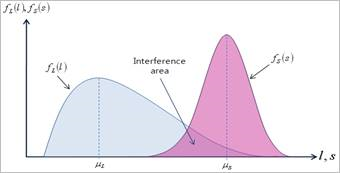21.4.6. Reliability Analysis
A mechanical or structural component is considered to be safe and reliable when the strength or resistance of component exceeds the value of load acting on it. Thus, the computation of the reliability of the component requires the knowledge of the random nature of the strength(\(S\)) and the load(\(L\)). If the probability density functions of \(S\) and \(L\) are known to be \({{f}_{S}}(s)\) and \({{f}_{L}}(l)\) as shown in Figure 21.145, then the reliability of the component can be evaluated by constructing integral equations. If \(S\) and \(L\) are independent, then the interference area shown in Figure 21.145, between the probability density functions of \(S\) and \(L\), gives a measure of the probability of failure. The reliability of a component \(R\) is given by
\(R=\Pr ob(S>L)=\iint{{{f}_{S,L}}(S,L)dsdl}\)
where \({{f}_{S,L}}(S,L)\) is the joint density function of \(S\) and \(L\). In certain cases, such as the cases in which \(S\) and \(L\) follow normal, lognormal, exponential distributions, the integral equation can be reduced to a simple form. However, in a more general case, the reliability of the component can be found only by evaluating the integrals numerically. Two methods of evaluating the reliability of mechanical components are discussed in this chapter.

Figure 21.145 Graphical representation for reliability analysis